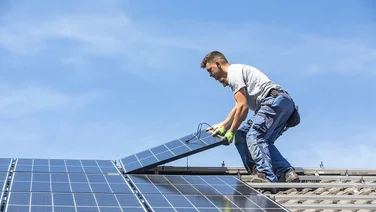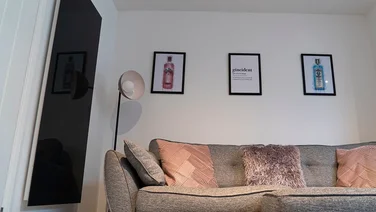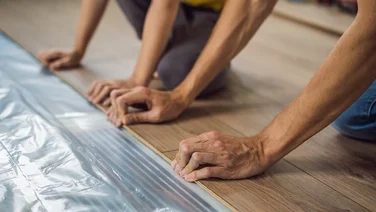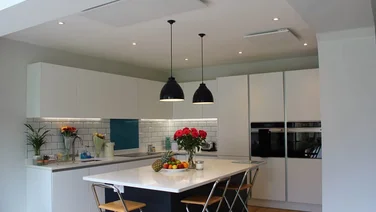- What are infrared heating panels?
- Pros and cons of infrared heating panels, at a glance
- What are the advantages of infrared heating panels?
- What are the disadvantages of infrared heating panels?
- How do I know if my property is suitable for infrared panels?
- Summary: Should I get infrared heating panels?
- Infrared panels heat up to full power in a few minutes
- They can be wall or ceiling mounted to provide radiant heat in your home
- They don’t work properly if anything is obstructing them

Infrared panels are a fairly unknown form of low-emission heating. Few people know what they are, let alone what the costs of infrared heating panels are.
They’re effective at heating your home and are especially useful in winter if you want to heat it during the coldest months. But, like many things in life, infrared heating panels also have downsides. In other words, they might not be for everyone.
Check out our helpful guide below to better understand whether infrared panels are right for you.
Once you’re ready to get yourself a set of infrared panels, you can get the ball rolling by using our easy-to-navigate tool. All you have to do is provide a few quick details, and our expert installers will be in touch with free bespoke quotes.

Get free infrared panel quotes
Answer a few quick questions, and our trusted installers will send you bespoke infrared panel quotes – for free.
What are infrared heating panels?
Infrared panels, or IR panels, are an electrical heating technology that uses infrared radiation to warm people and objects directly rather than indirectly by heating a body of air (like how a “radiator” works with your central heating). They use the kind of heat you experience from everyday things like the Sun or any hot body (like a fire or a hot cup of tea) from a distance.
For this reason, they are considered more efficient and, therefore, cheaper to run than more traditional heating systems like gas boilers or normal electrical heaters.
These panels can be placed on walls, ceilings, or even under floors and can even be sited outdoors. Because they use radiant heat, infrared panels require an unobstructed line-of-sight to people and objects to function efficiently.
Pros and cons of infrared heating panels, at a glance
| Pros | Cons |
|---|---|
Low emissions | The whole system is more expensive than the average gas boiler |
Aesthetically pleasing | There can’t be any obstructions |
Don’t take up much space | Runs on electricity, which is expensive |
Simple to install | Can’t fully replace a boiler |
Low maintenance | |
More efficient than central heating systems | |
Reduce energy consumption with ‘zoning’ features | |
Can have health benefits | |
No noise pollution | |
Can be connected to solar panels | |
Can be installed in listed buildings |
What are the advantages of infrared heating panels?
Infrared heating panels are highly efficient and effective, achieving up to 100% efficiency at the point of use while providing direct radiant heat that warms objects and people rather than just heating air. Here are the key benefits:
- Simple installation – Infrared panels are quick to set up, typically taking less than a day, with no need for pipework. Installation involves mounting the panels to a wall or ceiling and connecting them to an electric circuit. Some suppliers even include installation costs in the purchase price.
- Low emissions – Heating is responsible for an estimated 37% of UK CO₂ emissions (and around 50% of global emissions), meaning that infrared panels could significantly reduce energy usage and emissions. These panels heat objects directly, minimizing energy loss.
- Aesthetically pleasing – With their sleek design, infrared panels avoid the bulky look of traditional systems. They can be customized as mirrors, artwork, or photo displays, blending seamlessly with home décor.
- Space-saving – Infrared panels are compact and versatile, allowing for mounting on walls, ceilings, or placement on floors. Their flexible positioning avoids obstruction by furniture.
- Low maintenance – With no moving parts, infrared panels require minimal upkeep and no regular servicing. Occasional cleaning of reflectors keeps them in excellent condition.
- Highly efficient heating – Infrared panels achieve up to 100% at the point of use, meaning they outperform most traditional systems. They heat objects directly, warm up in 3–5 minutes, and allow zoned heating to avoid wasting energy in unused rooms.
- Energy-saving zoning – Panels can be placed strategically to heat frequently used or poorly insulated rooms, reducing energy consumption and lowering bills.
- Health benefits – Infrared heating avoids circulating dust, making it ideal for people with allergies or asthma. It can also help reduce dampness and improve respiratory health.
- Noise-free operation – Silent in use, infrared panels are perfect for quiet environments such as flats or suburban neighborhoods.
- Compatible with solar panels – Infrared systems can be paired with solar panels for clean, zero-cost energy. Although solar panel installation is costly, long-term savings on energy bills make it worthwhile.
- Ideal for listed buildings – Infrared panels are discreet and customizable, making them suitable for listed properties with restrictions on structural changes. Their adaptability ensures they blend into any interior design.
Infrared panels can be integrated into your home’s electricity system, which means they can be switched on or off in individual rooms whenever you like.


Get free infrared panel quotes
Answer a few quick questions, and our trusted installers will send you bespoke infrared panel quotes – for free.
What are the disadvantages of infrared heating panels?
The primary disadvantages of infrared heating panels are the high upfront cost, the need for clear space free from obstructions, and their reliance on expensive electricity. Here are the key considerations:
- More expensive than gas boilers – While individual panels are affordable, a full infrared heating system for a three-bedroom house costs around £6,000, significantly more than a gas boiler. Costs vary depending on panel type (e.g., £495 for wall-mounted, £380 for ceiling-mounted, £600 for mirrors) and the size of your property.
To give you some idea, we’ve listed the average cost of different types of infrared panels. Remember that you’ll need at least one panel in each room of your property.
*The overall price of infrared panels will depend on several factors, including the size and type of property and the installer you choose.
- Requires clear space – Infrared panels heat objects, not air, meaning they won’t function effectively if obstructed by furniture. Smaller homes may find ceiling panels a better solution, though these come at a higher cost.
- Runs on expensive electricity – Infrared panels use electricity, which is currently more expensive than gas (from 1st January 2025 to 31st March, costs will be 24.86p/kWh vs. 6.34p/kWh respectively). While their efficiency can lower energy bills, electricity prices may still impact overall savings.
- Can’t fully replace boilers – Infrared panels can heat your home but don’t heat water, so they can’t entirely replace a gas boiler. Pairing them with an electric immersion heater or water cylinder is a common workaround. However, advancements in water-heating infrared technology are being explored.
Want a better idea of how much infrared panels will cost you? Try using our personalised quote tool. All you have to do is pop a few details in the form, and we’ll put you in touch with trusted installers, who’ll provide you with free bespoke quotes.
How do I know if my property is suitable for infrared panels?
Most UK homes are suitable for infrared heating as the panels are compact, easy to install, and connect directly to standard electrical circuits. The panels are compact, affordable, and easy to connect to existing electrical circuits, making them a convenient option for many households.
That said, infrared panels work best when nothing is blocking their direct line of heat. This can pose challenges in smaller homes, but many companies address this by offering ceiling-mounted panels. These are lightweight, stay out of the way, and ensure unobstructed heating.
Infrared panels can’t fully replace boilers, as they typically can’t heat water. Homeowners can pair them with an electric immersion heater or water cylinder for a complete solution. Excitingly, infrared water heating systems are already in development and are expected to grow in popularity shortly.
Summary: Should I get infrared heating panels?
- Infrared panels offer up to 100% efficiency by directly heating objects, making them cost-effective and energy-efficient, meaning they are worth considering if you want to save cash on heating.
- These panels can double as mirrors, artwork, or personalized photo displays, blending seamlessly with home décor.
- Infrared panels are compact and can be mounted on walls, ceilings, or floors, ensuring unobstructed heating in any room.
- With no moving parts, infrared panels require minimal upkeep and are easy to clean for optimal performance.
- IR panels must remain unobstructed to work effectively, which can pose challenges in smaller homes.
- Infrared panels cannot heat water, so they must be paired with a boiler alternative, such as an electric immersion heater or water cylinder.
Think infrared panels would be perfect for your home? Find the perfect set of panels by using our easy-to-navigate tool. Simply pop a few quick details in the form, and our expert installers will be in touch with free quotes.
Alternatively, you can learn more about infrared panels by checking out some of our helpful guides below:
- Should You Get Infrared Heating Panels?
- A Beginner’s Guide to Infrared Heating Panels
- Infrared Heating Panel Costs

Get free infrared panel quotes
Answer a few quick questions, and our trusted installers will send you bespoke infrared panel quotes – for free.







